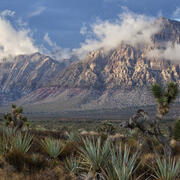Habitat Management
Habitat Management
Filter Total Items: 112
Recommendations for conducting landscape assessments to inform decision making on multiple-use public lands
Landscape assessments have been proposed as a mechanism for informing conservation and natural resource management actions at broad scales. We are documenting the process used in a large effort to conduct 14 such assessments across the western United States, and evaluating how the assessments were used in subsequent land use plans. In this project, we seek to identify methods and characteristics...
Greater Sage-Grouse Population Monitoring Framework
Greater sage-grouse ( Centrocercus urophasianus) are at the center of state and national land use policies largely because of their unique life-history traits as an ecological indicator for health of sagebrush ecosystems. Researchers within the U.S. Geological Survey (USGS) and Colorado State University (CSU) worked with the Bureau of Land Management (BLM) and state wildlife agencies to develop a...
USGS Science Syntheses for Public Lands Management
Scientific information is fundamental to understanding how proposed actions on public lands may impact the environment. Development of new science is occurring at rates that can make it challenging for biologists, resource managers, decision makers, private landowners, and other stakeholders to ensure they are using up-to-date, high-quality science information to inform their decisions. Further...
Land management research in support of streamlined energy development, economic growth, and wildfire management
FORT researchers provide sound science to support the Department of the Interior in its efforts to streamline reliable energy development, enhance cost efficiency in public lands management, and manage fire-prone habitats for public safety. This research is developed in partnership with resource managers from local, State, Federal and Tribal governments, industry, and nongovernmental organizations...
Ground-truthing an easy guide to biocrust morphogroups
Land and resource managers are increasingly aware of the contribution of biocrusts to ecological functions and have expressed interest in training and resources to recognize biocrusts in the field. This knowledge will help enable managers to address biocrusts in carrying out analyses under the National Environmental Policy Act (NEPA). WERC scientists have drafted a single page, easy guide to...
State of Knowledge of Biological Soil Crusts: A synthesis of work to inform land management.
Land and resource managers are increasingly interested in up-to-date information for biocrust conservation and management. To facilitate the use of evolving science by land managers, WERC scientists are compiling a synthesis of recent work on biocrusts related to their ecology and management. This knowledge will help enable managers to address biocrusts in carrying out analyses under the National...
WebDART: A Cutting-edge Web Tool that Evaluates Land Condition
WebDART is an online ecological assessment tool available to a wide audience that incorporates Landsat satellite remote sensing imagery, topography, geology, soil conditions, and rangeland geospatial and vegetation mapping to compare altered terrain with an unspoiled area that has similar characteristics in the same region. The tool gives resource managers, landowners, companies, and other...
Supporting energy and mineral development through successful reclamation
Federal lands of the US contain important reserves of oil, gas and other resources important for Unleashing American Energy (SO 3418). After development of these resources is complete, successfully reclaiming disturbed lands is a necessary step towards restoring wildlife habitat, forage production, and maintaining natural resources for future use. To improve reclamation outcomes on these lands and...
Fostering greater use of habitat models for managing rare and invasive plants on public lands
Habitat models can provide critical information on the current and potential distribution of plant species, as well as help target and support conservation efforts. Despite their potential utility in public land management, model use may be constrained by a variety of factors including staff access to and trust in models. In this project, we seek to bring together model users and model developers...
USGS Technical Transfer for Department of War Installations in the Sagebrush Biome
The USGS has initiated a new collaboration effort with Department of War (DoW) in the sagebrush biome. The goal of this effort is to establish a network with DoW resource managers to define pervasive natural resource issues facing DoW installations and to identify existing innovative USGS science and tools that support DoW resource managers. Through this effort, the USGS will provide subject...
Economic Implications of Sagebrush Treatment and Restoration Practices Across the Great Basin and Wyoming
USGS and Colorado State University researchers are conducting analyses and predictions of sagebrush recovery in the Great Basin and Wyoming and assess the role of weather, soils, and reseeding treatments.
FORT Cottonwood Common Garden
FORT scientists established a Common Garden at the Colorado State Forest Service Nursery in Fort Collins, Colorado in 2005 to study the phenology of riparian cottonwood in relation to annual variation in temperature. Phenology is the seasonal timing of life history events including leaf opening, flowering, seed release, bud formation and leaf senescence.













